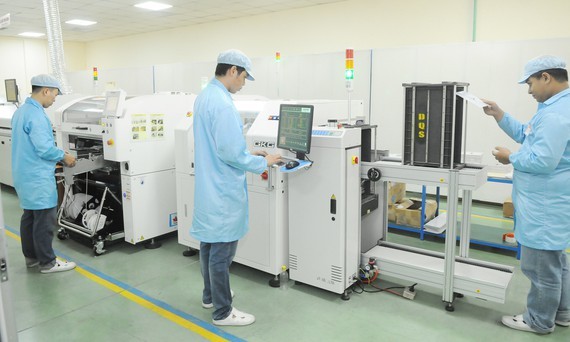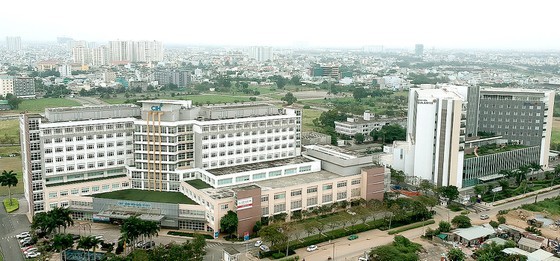
Analyzing the investment situation in the city, the Department of Planning and Investment said that the leader was the commercial and service sector with the registered capital of VND584 trillion, an increase of 53.7 percent over the same period last year. The industrial and construction sector came next with the registered capital of VND81 trillion, but compared to the same period last year, it decreased by 29.2 percent. In contrast, in the processing and manufacturing sector, although the registered capital was only nearly VND19 trillion, it increased by 38.2 percent compared to the same period last year. Moreover, the agriculture, forestry, and fishery sector had VND2.9 trillion of registered capital, two times higher than that in the same period last year.
As for the situation of foreign investment license issuance alone, the total foreign investment capital in the city is still very positive, reaching US$3.25 billion, including newly-registered capital, adjusted capital, and capital contribution and purchase of shares of foreign investors. Singapore leads with total investment capital of $813 million, accounting for 25 percent of total FDI capital in the city, followed by South Korea with $515 million, accounting for 15.9 percent.
The remaining countries and territories are mainly the British Virgin Islands, Japan, Cayman Islands, the Netherlands, and the US. According to the city’s Department of Planning and Investment, compared to the same period last year, total foreign investment dropped by 28 percent. However, in the context of a complicated Covid-19 pandemic, greatly affecting the international trade and investment activities, this is still seen as an optimistic signal.
In the field of export, Mr. Nguyen Phuong Dong, Deputy Director of the Department of Industry and Trade of HCMC, said that although the export failed to keep the high growth momentum as last year, the export turnover of city-based enterprises at border gates across the country still reached $32.6 billion in the first nine months of this year, up 4.9 percent over the same period last year. Some commodity groups still maintained positive growth. Specifically, the group of agricultural products, rice, coffee, forest products, and industrial goods had a growth of 3-6 percent.
Especially, two groups of goods with a sharp increase in export turnover are computers, electronic products, and components with an export value of $13 billion, an increase of 22 percent, and seafood products with an export value of $846 million, up 12.1 percent.
To maintain the above growths, previously, the city’s People's Committee directed the export processing zones and industrial parks to review their infrastructure, at the same time, deploy the construction of more high-rise factories to meet diversified investment needs of enterprises.
Regarding import and export activities, the city’s Department of Customs has also applied two projects, namely customs procedures in logistics operations, congestion prevention at Cat Lai Port, and the HCMC customs administration system, allowing the application of digital technology in quickly solving customs clearance procedures for enterprises.
Especially, the city surveyed 300 enterprises in four key industrial sectors and supporting industries to determine the need for loans, thereby connecting with the commercial banking system for support.
As for the situation of foreign investment license issuance alone, the total foreign investment capital in the city is still very positive, reaching US$3.25 billion, including newly-registered capital, adjusted capital, and capital contribution and purchase of shares of foreign investors. Singapore leads with total investment capital of $813 million, accounting for 25 percent of total FDI capital in the city, followed by South Korea with $515 million, accounting for 15.9 percent.
The remaining countries and territories are mainly the British Virgin Islands, Japan, Cayman Islands, the Netherlands, and the US. According to the city’s Department of Planning and Investment, compared to the same period last year, total foreign investment dropped by 28 percent. However, in the context of a complicated Covid-19 pandemic, greatly affecting the international trade and investment activities, this is still seen as an optimistic signal.
In the field of export, Mr. Nguyen Phuong Dong, Deputy Director of the Department of Industry and Trade of HCMC, said that although the export failed to keep the high growth momentum as last year, the export turnover of city-based enterprises at border gates across the country still reached $32.6 billion in the first nine months of this year, up 4.9 percent over the same period last year. Some commodity groups still maintained positive growth. Specifically, the group of agricultural products, rice, coffee, forest products, and industrial goods had a growth of 3-6 percent.
Especially, two groups of goods with a sharp increase in export turnover are computers, electronic products, and components with an export value of $13 billion, an increase of 22 percent, and seafood products with an export value of $846 million, up 12.1 percent.
To maintain the above growths, previously, the city’s People's Committee directed the export processing zones and industrial parks to review their infrastructure, at the same time, deploy the construction of more high-rise factories to meet diversified investment needs of enterprises.
Regarding import and export activities, the city’s Department of Customs has also applied two projects, namely customs procedures in logistics operations, congestion prevention at Cat Lai Port, and the HCMC customs administration system, allowing the application of digital technology in quickly solving customs clearance procedures for enterprises.
Especially, the city surveyed 300 enterprises in four key industrial sectors and supporting industries to determine the need for loans, thereby connecting with the commercial banking system for support.
 High-tech medical area in Binh Tan District in HCMC. (Photo: SGGP)
High-tech medical area in Binh Tan District in HCMC. (Photo: SGGP)
Mr. Tran Viet Anh, Vice Chairman of the HCMC Union of Business Associations, said that as for enterprises that are still active in the market, the pandemic created compression in production and business activities. This compression will bounce back as soon as the pandemic is under control. In fact, after the pandemic was basically controlled, more than 6,000 enterprises have resumed operations. Along with that, there have been more than 30,000 newly-established enterprises with registered capital of VND696 trillion. In which, there are 579 newly-established enterprises with registered capital of over VND100 billion. This shows great internal resources and resilience of city-based enterprises. The problem is that the city needs to accelerate supportive solutions to create favorable conditions for enterprises to flourish.
According to many enterprises, the city needs to immediately carry out synchronously many solutions to support enterprises to maintain internal production capacity, implement administrative reform to create openness for import and export activities, and importantly, strengthen the infrastructure of the export processing zones and industrial parks to welcome the wave of foreign investment pouring heavily into Vietnam. Economic experts said that, in the short term, the city needs to quickly improve the infrastructure of the export processing zones and industrial parks, focusing on determining the unit price of land rent, simplifying procedures for licensing factory construction permits for enterprises.
Regarding import and export activities, it is essential to open up administrative procedures at customs border gates. At the same time, the city needs to propose the State Bank of Vietnam to reserve a certain amount of foreign currency to prepare for when enterprises increase the import of raw materials for production when the global market recovers. The reality has proven that as long as enterprises do not go bankrupt, they will soon recover and will strongly rebound as a compressed spring in the new normal conditions.
At the recent seminar on restoring and developing the economy of HCMC, Mr. Nguyen Thanh Phong, Chairman of the People's Committee of HCMC, affirmed that as for the city’s economic recovery, in the short term, the operation of enterprises, in general, must be restored. Enterprises are an important part, creating wealth for society and creating jobs. At the same time, this is also a part that contributes to stimulating consumer demand and promoting the disbursement of public investment.
According to many enterprises, the city needs to immediately carry out synchronously many solutions to support enterprises to maintain internal production capacity, implement administrative reform to create openness for import and export activities, and importantly, strengthen the infrastructure of the export processing zones and industrial parks to welcome the wave of foreign investment pouring heavily into Vietnam. Economic experts said that, in the short term, the city needs to quickly improve the infrastructure of the export processing zones and industrial parks, focusing on determining the unit price of land rent, simplifying procedures for licensing factory construction permits for enterprises.
Regarding import and export activities, it is essential to open up administrative procedures at customs border gates. At the same time, the city needs to propose the State Bank of Vietnam to reserve a certain amount of foreign currency to prepare for when enterprises increase the import of raw materials for production when the global market recovers. The reality has proven that as long as enterprises do not go bankrupt, they will soon recover and will strongly rebound as a compressed spring in the new normal conditions.
At the recent seminar on restoring and developing the economy of HCMC, Mr. Nguyen Thanh Phong, Chairman of the People's Committee of HCMC, affirmed that as for the city’s economic recovery, in the short term, the operation of enterprises, in general, must be restored. Enterprises are an important part, creating wealth for society and creating jobs. At the same time, this is also a part that contributes to stimulating consumer demand and promoting the disbursement of public investment.
























